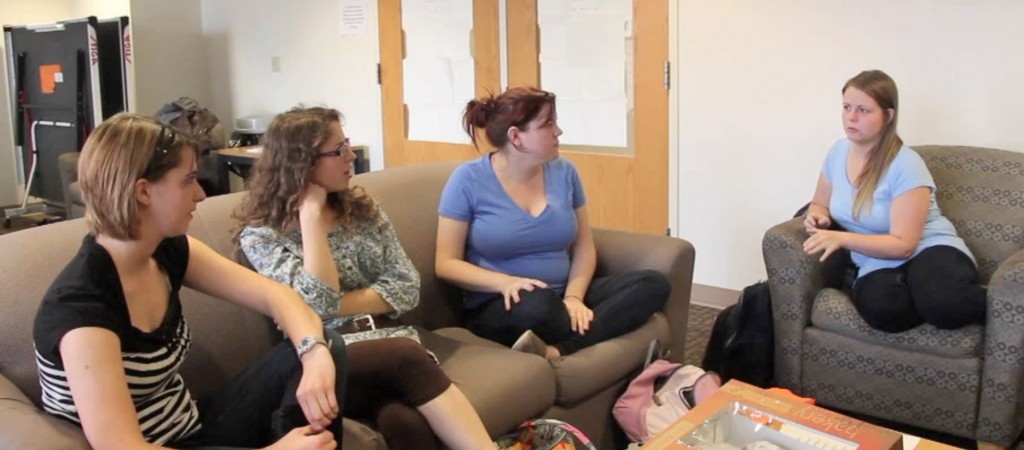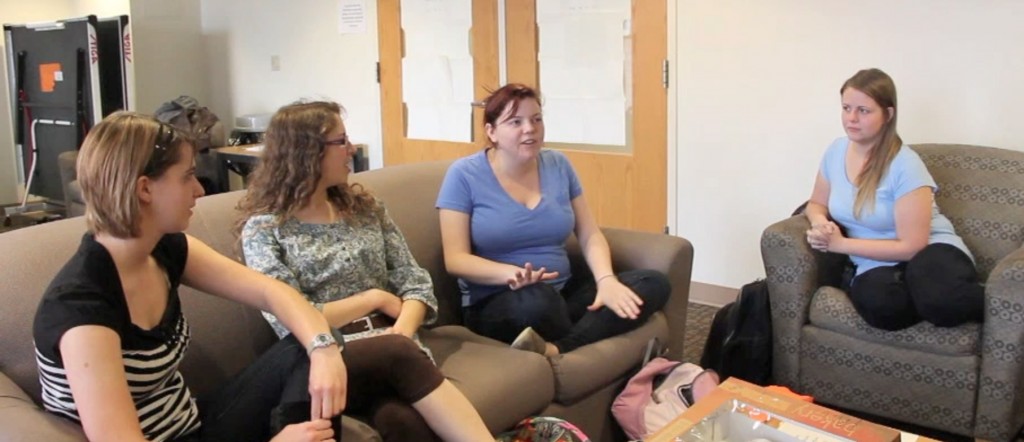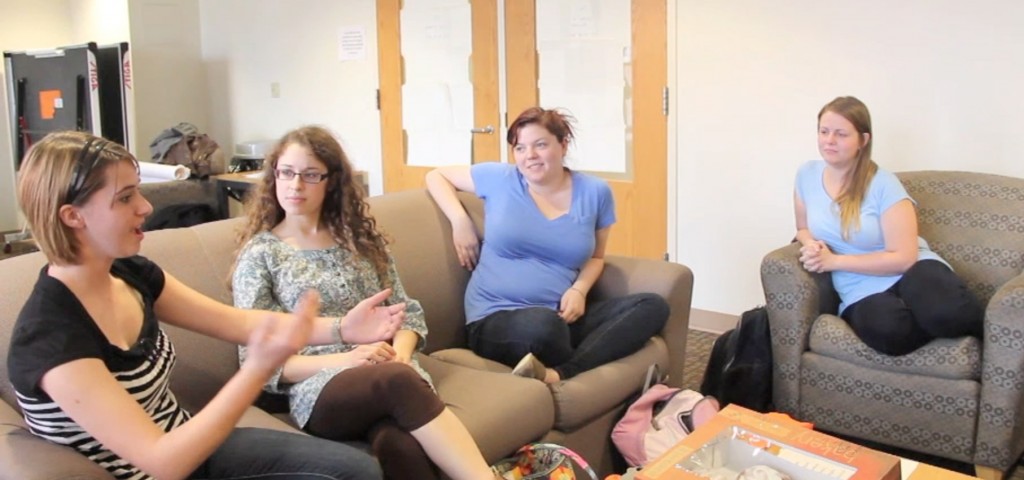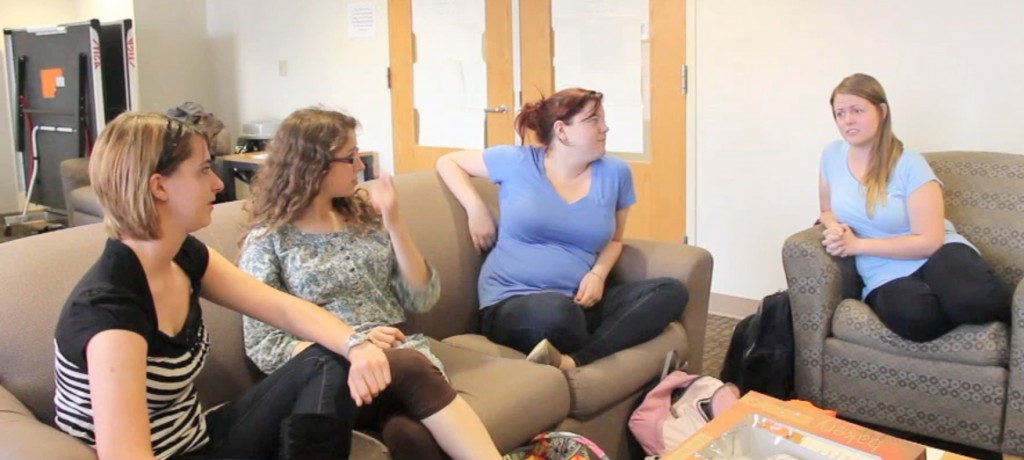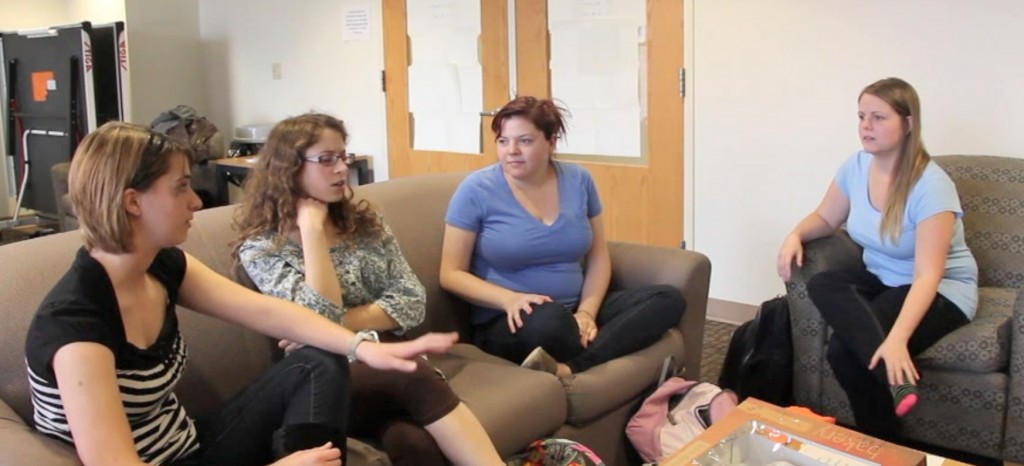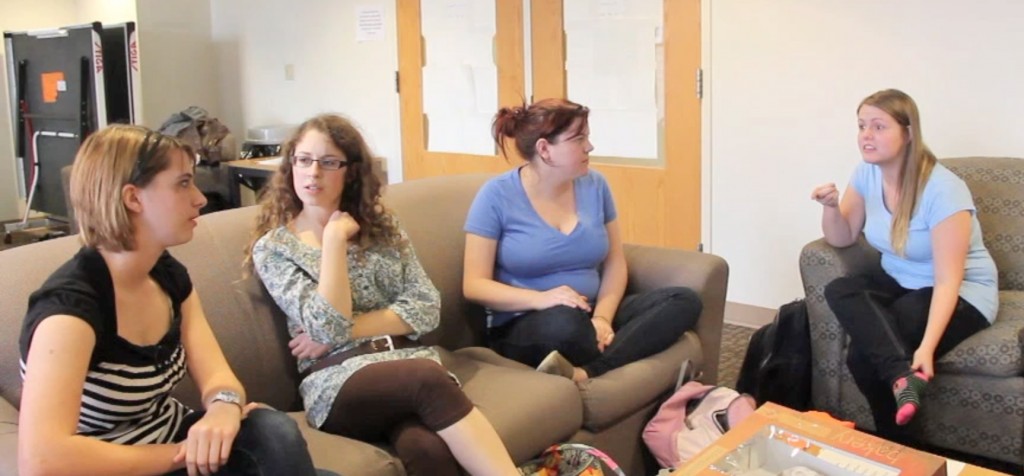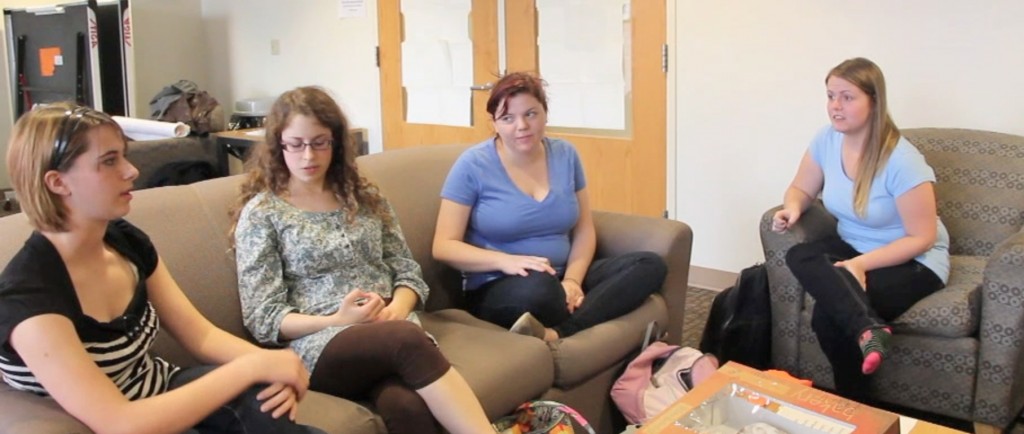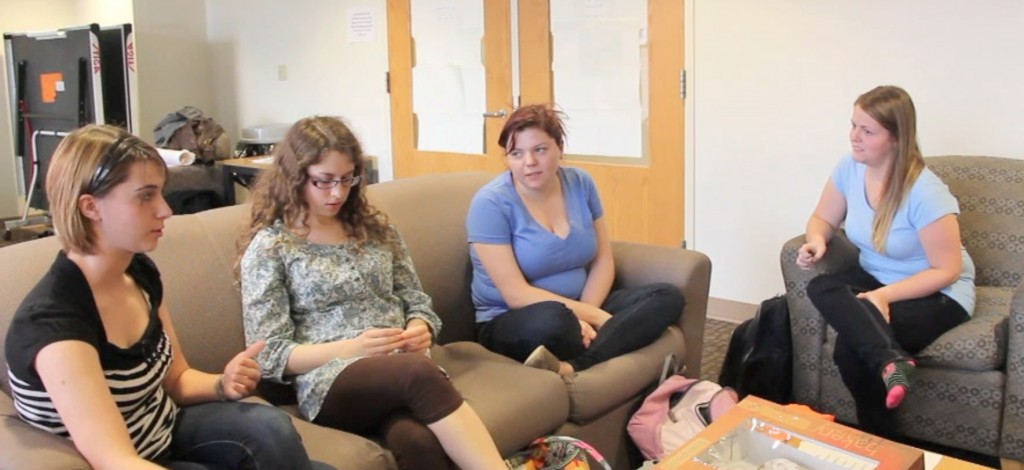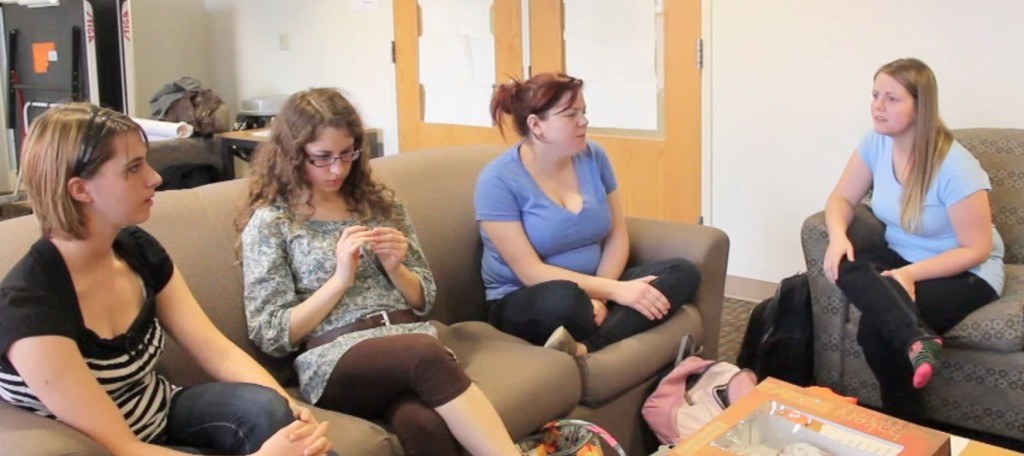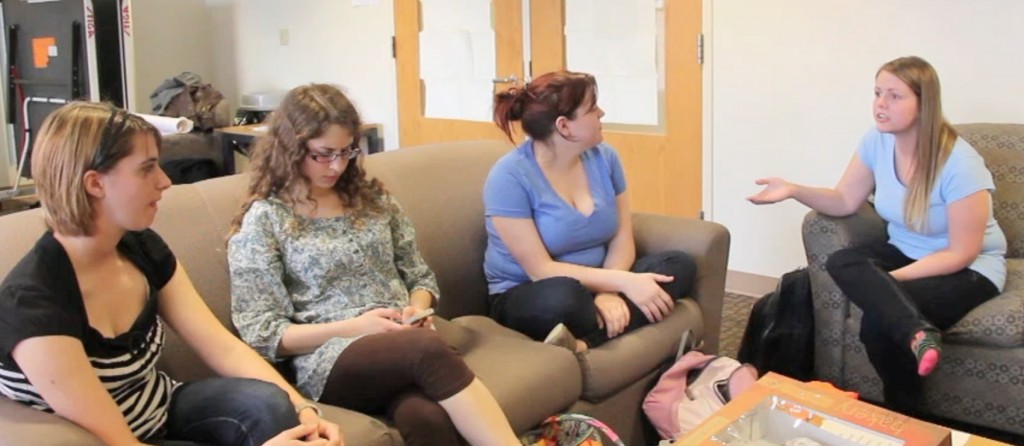Exercises for Showing Interest
 Photo Exercise: Reading Interest in Faces
Photo Exercise: Reading Interest in FacesFor each of the photos, identify whether each listener is displaying A) real interest (and/or amusement) in what is being said, B) interest in the speaker but not necessarily in what is being said (the “fake” (social) smile), or C) no interest at all (in speaker or topic). Remember that you would expect to see BOTH A & B expressions in the course of a good conversation. (If someone only gives social smiles, never looking genuinely interested, that would indicate a problem, and obviously any C expressions indicate a problem.)
#1
#2
#3
#4
#5
#6
#7
#8

Answers
#9
#10
#11
#12
 Photo Exercise:
Photo Exercise:In the sequence of photos (captured during a videotaped conversation), track the interest level of all the participants. Are they all genuinely interested in the discussion? If any of them lose interest, at which point in the sequence does this seem to occur?
#1
#2
#3
#4
#5
#6
#7
#8
#9
#10
Discussion/Answers
The woman in glasses (second from left) loses interest in the conversation by the 5th tab. (She was actually never interested in the conversation at all, she told me, but was being polite in the first minute or so.) She took no turns herself, but in tabs 1-4, we see her following the conversation with her gaze. After that, she never looks at whoever is speaking. In tab 6, she actually has her head turned away from the speaker. She begins to engage in alternate activities, checking her fingernails, and then finally pulling out her cellphone. Her expression in tabs 5-10 is bored and increasingly unhappy (presumably because the others have ignored the social signals that she is sending, and have not changed the subject).
The other three all seem interested in the conversation. While each of them occasionally displays a social (as opposed to genuinely happy or amused) smile, they all follow the speaker with their gaze, and they all continue to take turns themselves.
 Video Exercise: Active Listening in Context
Video Exercise: Active Listening in ContextIn this webcam footage, we see a minute and a half of a long meeting between a student and her faculty advisor. She holds the floor for most of the time in this excerpt (talking about what courses she needs to take to graduate). What active listening behaviors do you see him perform?
Answers
1) The professor gives frequent minimal responses (Yeah, yes, okay, mm, etc.). He does this practically every time she reaches the end of a sentence! 2) He asks several questions that are intended to clarify, to make sure he understands what she’s saying. (These are quickly interjected questions, clearly not looking to take the floor away from her, but encouraging her to continue explaining her train of thought.) 3) He looks away for a second (in deep thought), but then immediately leans in again towards her, to show that he’s back, focusing on what she’s saying. 4) He nods frequently, even when she’s not looking at him. 5)They are both mostly focusing their gaze on a piece of paper she has prepared, listing possible courses for her to take. By alternating his gaze between her and the paper, he shows that he is entirely focused on the topic at hand. 6) Of course, at one point he even explicitly says “That’s interesting.”
You might think that this is overkill: 6 different ways of showing interest (particularly since some of the ways themselves are frequently repeated), but it’s not! He’s a wonderful listener, and his students really appreciate it.
 Role Play/Video Modeling Exercise: Social Smiles & Laughs
Role Play/Video Modeling Exercise: Social Smiles & LaughsHave a confederate tell you a longish (2 minutes or more), supposedly funny story, with the camera pointed towards you. As you are listening, give an occasional “fake” smile and at least one “fake” laugh.
Did the confederate feel that your response was natural and appropriate? (It’s quite common, when acquiring a new behavior, to overdo it, to the point where the speaker might feel like you’re sarcastic.) Did your confederate feel that you were interested in the story? If not, watch the video together, with special attention to when the “fake” smiles and laughs occurred, and to what other behaviors may have seemed to contradict the message of support you were trying to send to the storyteller.
With luck, there will have been moments that you were genuinely amused. (If not, try this exercise again with a different story and/or with a funnier confederate!) Compare your reactions of genuine amusement with the more deliberate signals. Freeze the frames at the right times so you can see the difference in facial expressions, and re-listen to hear the difference between your real laugh(s) and your fake one(s).
 Role Play/Video Modeling Exercise: Other Active Listening Strategies
Role Play/Video Modeling Exercise: Other Active Listening StrategiesUsing the lists we gave of verbal and nonverbal active listening strategies, rewatch the video you made for the previous exercise to see which techniques other than fake smiles and laughs you used, and which ones were entirely absent. Were you conscious of using any of these techniques? If there are some you used unconsciously, congratulations — you’ve got a head start in developing good active listening skills! If there were some that were entirely absent, repeat the previous exercise, but instead of fake laughs and smiles, practice a single active listening technique you identified as missing. Repeat as many times as necessary for each technique that was missing.
 Role Play/Video Modeling Exercise: Noticing Active Listening in Others
Role Play/Video Modeling Exercise: Noticing Active Listening in OthersNow it’s your turn to tell a story to a confederate (with the camera pointing at the confederate), or to explain to the confederate how to do something. Ask them to decide (but not tell you) before you begin whether or not to show interest in what you’re saying. Could you tell if they were interested? What signs of active listening did you notice? Go back and watch the video, and ask your confederate to point out other signs that you might have missed. Notice that even if they were trying to appear uninterested, they probably did give you some active listening cues – because most people can’t turn it off completely, if they like the person they’re interacting with. (It would feel too rude.)
Repeat this exercise a few times (telling different stories or explaining how to do different things) with the same confederate, so you can compare the truly interested performances and the just-being-polite performances. Can you see the difference in the sincerity of the facial expressions? In the intensity of the minimal positive responses? In the amount of eye contact?
Repeat the exercise again with a different confederate. Before you watch the videos together, ask the confederate to discuss how they showed interest or lack thereof. Did you notice cues that they don’t mention? (Most people aren’t even consciously aware of their social signalling!) Watch the videos together and discuss all the active listening cues you see. Did this confederate use the same active listening strategies as the first confederate?
If you have trouble making appropriate amounts of eye contact, try getting a few people together to play this game. It helps!











